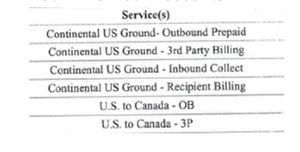Reverse Logistics: Maximizing Discounts On Returns

For FedEx Weight Based Discounts, applicable billing methods will be listed on the chart next to the service level:
And for UPS, applicable billing methods will be listed at the top of each chart:
Billing Methods:
Now that you know where to look, you need to know what to look for. Generally, there are two main types of billing that may be used for returns, and they are dependent on who it is that initiates the shipment and manifests the label.The first, and less commonly used, method applies in situations where the customer making the return in the one to initiate the shipment. For example, the customer is printing the label or dropping of the package to a Fedex or UPS location and instructing them to bill it to your account. This is referred to as Freight Collect for UPS and Recipient Billing (RB) for Fedex.
The second and vastly more common method is when you the recipient is initiating the shipment and manifesting the label. For example sending your customers and electronic or pre-printed return label on your packages. This method is referred to as Return Services (RS) by UPS and Returns Manager (RM) for Fedex.
One a somewhat unrelated note, some shippers using UPS will mistakenly select 3rd Party Billing when manifesting return labels. As 3rd Party Billed shipments accrue a 2.5% surcharge, this should only be used in the correct situations. The only time 3rd party billing or Returns Third Party (RTP) should be used is when neither the shipper or recipient of a package will be paying for it. For example, when a customer makes a return to a companies 3rd party warehouse, but bills the shipment to the account of the company they bought the product from.
UPS Returns Discounts:
In most situations, UPS contracts will attribute discounts to return shipments by default. However, there are certain cases where they aren’t, and more commonly, cases where they are later removed during renegotiation.Regardless, it never hurts to check. The proper returns billing labels will be marked Return Services(RM) and Returns Third Party (RTP) if applicable. They will appear listed above each bracket of discounts listed on your contract like this:
In rare cases, individual billing methods may also have discounts listed for them.
Fedex Returns Discounts:
Shippers using Fedex will need to be much more mindful fo their return discounts, as they are extremely rarely included by default. To ensure your returns are fully discounted with FedEx you'll need to confirm two things.Firstly, make sure that both Recipient Billing (RB) and Returns Manager (RM) are listed as applicable billing methods for your discounts. Recipient Billing will more commonly be listed by default. Many reps will honestly, but mistakenly, claim that your returns will be discounted so long as they apply to RB. However, the vast majority of your returns will likely fall under Returns Manager (RM).
Secondly, you'll need to make sure that RM is listed on both earned and weight based discounts. In some cases, RM will be a default billing method for weight based discounts. But earned discounts, which will likely make up a bulk of your total discounts will almost never apply to RM by default.
What If Your Discounts Don't Apply
If you checked your contract and all of your discounts apply to the proper returns billing method, then congratulations, you've just earned yourself some peace of mind. But more than likely, you might have noticed the RM missing from a few of your key discounts.Ultimately, if the case is the later, this is something you'll have to take up with your UPS or FedEx rep. However, having your discounts extended to returns isn't extremely difficult to accomplish. Your awarded discounts based on your entire shipping volume, so there's almost no possible justification for withholding discounts from your returns shipments. Even if you're not going to renegotiate your entire contract, you can likely take this up with your carrier rep and have it sorted out, all you have to do is call it out. And if you need help with the process reaching out to a third party contract negotiator may be beneficial.